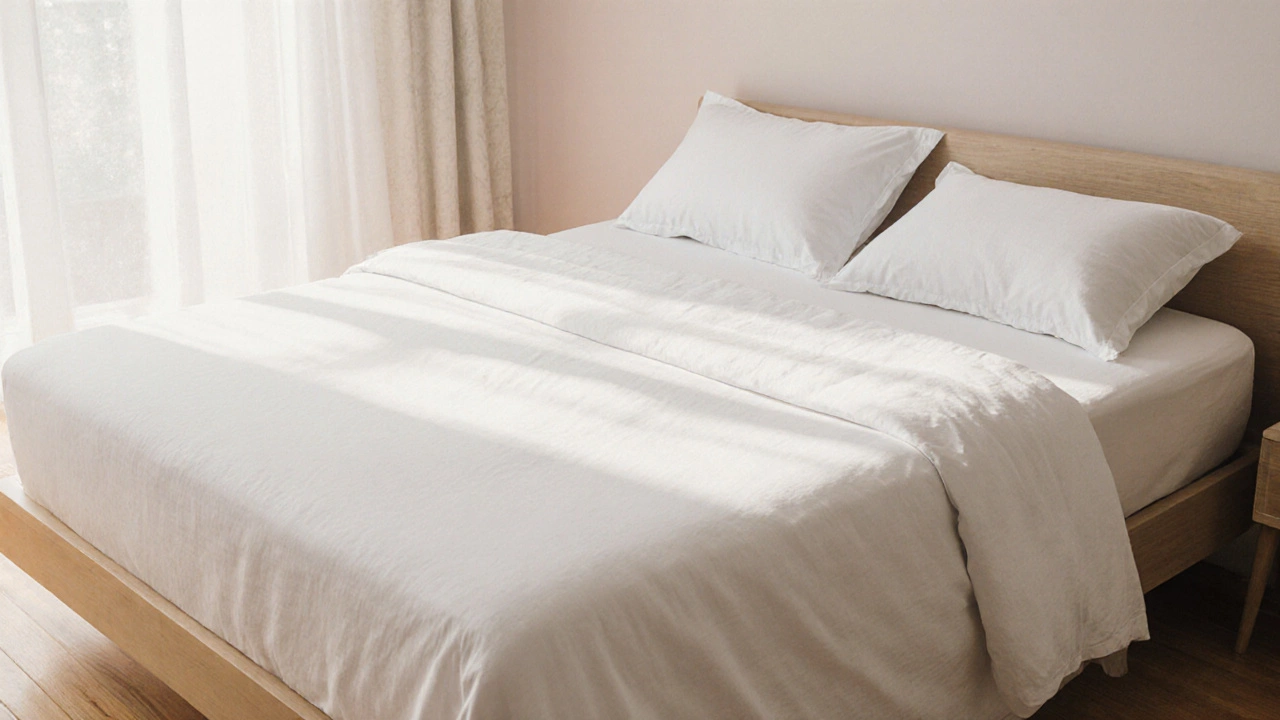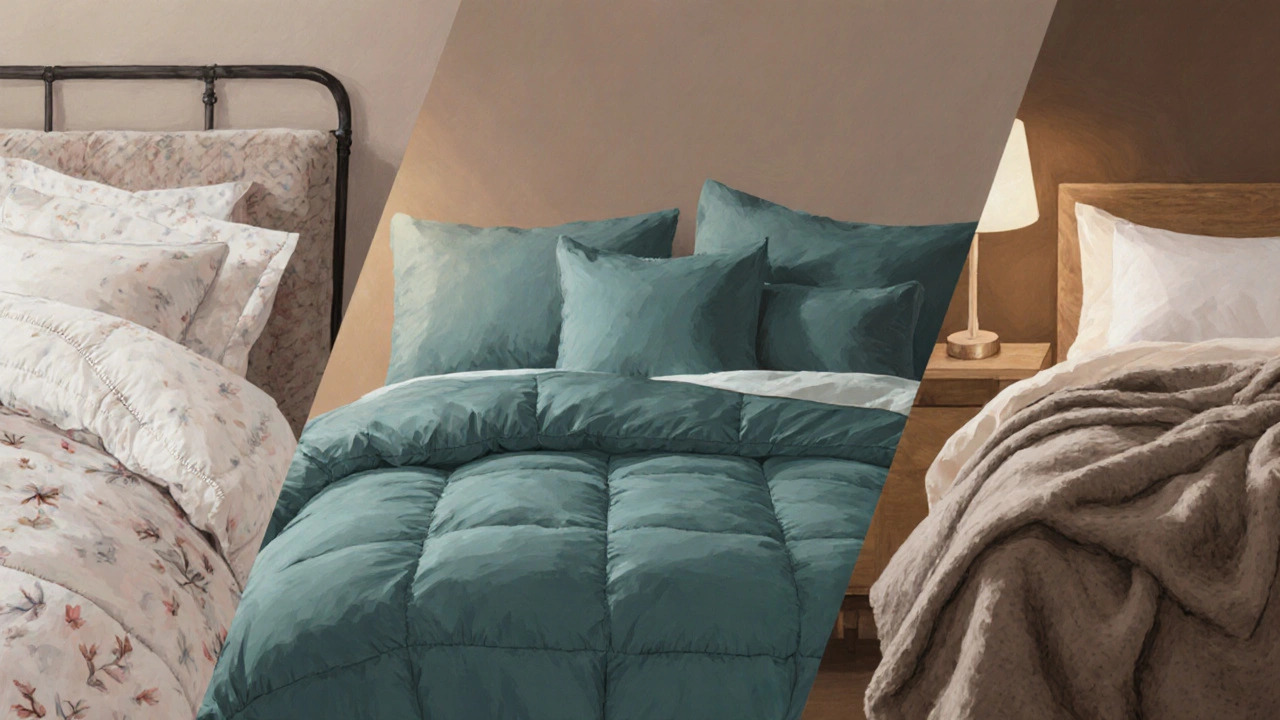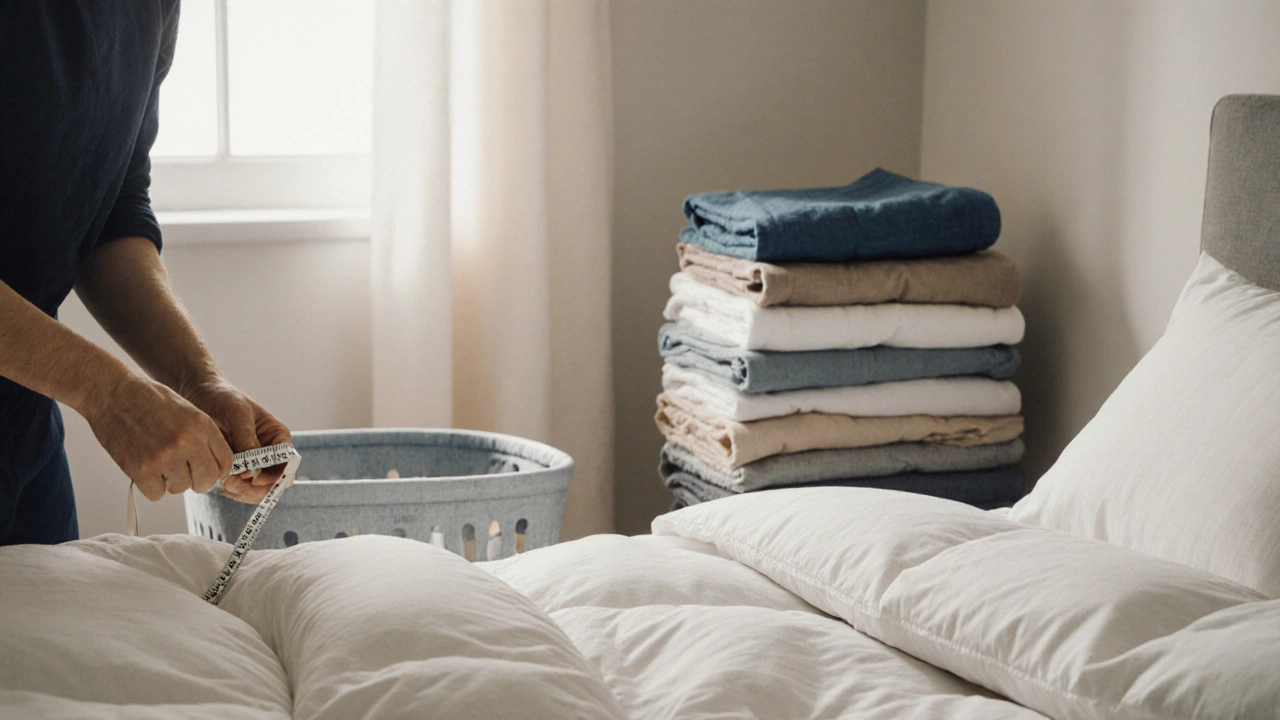Two Main Types of Bedding Explained - A Complete Guide

Bedding Selection Calculator
Find Your Perfect Bedding Combination
Answer these questions to get personalized recommendations for your bedding needs.
When you walk into a bedroom, the first thing you notice is the bedding types that dress the bed. Knowing the two basic families of bedding helps you pick the right pieces for comfort, style, and maintenance. Below we break down the two categories, dive into their sub‑components, and give you practical tips for choosing and caring for each.
Quick Takeaways
- The two overarching bedding families are sheet sets (the base layers) and cover bedding (the top layers).
- Sheet sets keep the mattress clean and comfortable; cover bedding adds warmth and visual flair.
- Match fabric, thread count, and construction to your climate, sleeping habits, and décor.
- Proper care prolongs life - wash sheets weekly, cover pieces monthly, and follow care labels.
Defining the Core Concept: Bedding is the collection of textiles that cover a mattress, provide warmth, and enhance the look of a bedroom
Bedding isn’t just about staying warm; it’s a blend of function and style. Over the years manufacturers have grouped all bedroom textiles into two logical families. Understanding this split simplifies buying decisions and makes laundry day less confusing.
Family One - Sheet Sets
A sheet set forms the foundation of any bed. It directly contacts the sleeper, so comfort, fit, and breathability matter most.
Key Components
- Flat Sheet - a rectangular piece that lies on top of the mattress and under a blanket or duvet.
- Fitted Sheet - a sheet with elastic corners designed to hug the mattress securely.
- Pillowcase - a protective sleeve for each pillow.
When you buy a "sheet set" you typically get a fitted sheet, a flat sheet, and two pillowcases (sometimes one extra for a decorative pillow). The set can be made from cotton, linen, microfiber, bamboo, or blends. Look for a thread count between 200 and 400 for a balance of softness and durability; higher counts feel smoother but can be less breathable.
When Sheet Sets Shine
- Warm climates - lightweight cotton or linen sheets let heat escape.
- Allergy‑prone sleepers - natural fibers resist dust mites.
- Frequent launderers - sheet fabrics are built for weekly washing.

Family Two - Cover Bedding
Cover bedding sits on top of the sheet set and provides the bulk of warmth and visual impact. This family includes several distinct pieces, each with its own construction and usage.
Major Types of Cover Bedding
- Duvet - a soft, fluffy insert that goes inside a decorative cover (the duvet cover). Duvets are typically filled with down, feather, or synthetic fibers.
- Comforter - a stitched blanket with the filling sewn directly between two layers of fabric. It’s ready to use without a separate cover.
- Blanket - a single layer of woven or knitted fabric, often made of wool, cotton, or fleece, used for light warmth.
Each type can be chosen based on climate, aesthetic preference, and ease of maintenance. Duvets are popular for their versatility - swap the cover to change the room’s look. Comforters appeal to those who want a “set‑and‑forget” solution. Blankets add an extra layer without bulk.
Choosing the Right Cover Bedding
| Feature | Duvet | Comforter | Blanket |
|---|---|---|---|
| Warmth Level | Variable (depends on insert) | Fixed, medium-high | Light‑to‑medium |
| Ease of Styling | High - change cover anytime | Low - built‑in design | Medium - accessories like throws |
| Cleaning | Cover washable; insert dry‑clean or gentle wash | Whole piece machine‑washable (check label) | Usually machine‑washable |
| Cost | Mid‑range (duvet + cover) | Mid‑range to high | Low to mid |
| Best For | Seasonal changes, design flexibility | Minimal fuss, consistent warmth | Layering, cooler nights |
How to Match Sheet Sets and Cover Bedding
While the two families serve different purposes, they work best when coordinated. Here’s a quick checklist:
- Pick a sheet fabric that feels comfortable against your skin (cotton percale for crispness, sateen for silkiness, linen for breezy feel).
- Choose a cover piece with a weight that complements the sheet’s thickness - a heavy duvet over a thin flat sheet can feel swaddling; a light blanket over a plush duvet may feel unnecessary.
- Match colors or patterns sparingly. A neutral sheet set pairs well with a bold duvet cover, while patterned sheets can be balanced with a solid‑color comforter.
- Consider the climate: In temperate zones, a medium‑weight duvet with a breathable cotton sheet set offers year‑round comfort.
Care and Maintenance Tips
Proper care extends the life of both families.
- Sheets: Wash weekly in warm water (40 °C) with mild detergent. Avoid bleach on colored fabrics. Tumble dry low or line‑dry to reduce shrinkage.
- Duvet Insert: Follow the label - most down inserts can be machine‑washed on a gentle cycle with tennis balls to fluff. Synthetic fills tolerate hotter washes.
- Duvet Cover / Comforter: Remove covers weekly; wash the cover as you would sheets. Comforters often need a larger washing machine; if not possible, consider professional cleaning.
- Blanket: Wool blankets benefit from hand‑washing or a wool‑specific cycle; fleece blankets are machine‑friendly.
Store off‑season pieces in breathable cotton bags rather than plastic; this prevents mildew and preserves loft.

Common Mistakes to Avoid
- Buying a fitted sheet that’s too small for a mattress depth - measure thickness before purchase.
- Choosing a duvet fill that’s too light for your climate - a 10 oz/down pillow is fine for summer, but a 30 oz fill is better for winter.
- Mixing high‑pile fabrics with low‑pile ones, resulting in an uneven look.
- Skipping the pillowcase - a pillow without a case invites oils and sweat to damage the mattress surface.
Mini‑FAQ
What’s the difference between a duvet and a comforter?
A duvet is an insert that sits inside a removable cover, allowing you to change the look easily. A comforter is a single stitched piece with the filling sewn in, so its appearance and warmth are fixed.
Do I need a flat sheet?
Flat sheets add a layer of comfort and protect the duvet or blanket from body oils. Some people skip it for a minimalist bedroom, but it does make cleaning the top layer easier.
Which fabric is best for hot sleepers?
Linen and percale cotton have excellent breathability and moisture‑wicking properties, keeping you cool throughout the night.
How often should I wash my duvet cover?
Aim for once a month, or more often if you have allergies. The insert itself can be washed less frequently - every 3‑6 months, depending on the fill.
Can I mix a cotton sheet set with a wool blanket?
Yes. Cotton provides a cool, breathable base, while a wool blanket adds warmth on top. Just ensure the blanket’s size matches your mattress dimensions.
Next Steps for Every Sleeper
Ready to refresh your bed? Start by measuring your mattress depth and width. Then decide whether you want the styling flexibility of a duvet or the low‑maintenance charm of a comforter. Pick a sheet set fabric that matches your climate and personal feel‑preference. Finally, set a cleaning schedule so your bedding stays fresh year after year.
With the two main bedding families clearly mapped out, you’ll find it easier to shop confidently, style creatively, and maintain your sanctuary for the long haul.